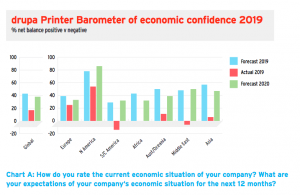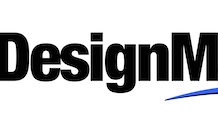Drupa’s newly released report series tracks key economic and market developments across the globe in all seven regions and the main market sectors. The survey conducted in November 2019 had nearly 800 participants with a good cross section from most regions and markets. Printfuture (UK) and Wissler & Partner (Switzerland) conducted and authored this report series.
7th drupa Global Trends Report 2020 – Executive Summary
It should be noted that the survey was completed before the coronavirus outbreak. Globally there was a net positive balance of 17% more printers who described their company’s economic condition as ‘good’ compared with those that reported as ‘poor’ (see Chart A).
That net balance was even stronger for Europe (+25%) and North America (+54%) but confidence had fallen in the remaining regions. It was a similar story for suppliers for Europe and North America, though they reported a far better net positive balance for 2019 in the developing regions; with the Middle East +45% higher, South/Central America +35% higher, Africa +30% higher and Asia +25%.

The reason for the caution amongst printers is clear when you view how revenues, prices, margins and utilisation have changed over the last 12 months (Chart B). Outside Europe and North America, the regional reports were challenging, although the Middle East reported an improvement. For suppliers, while revenues climbed in all regions except Australia/Oceania, prices fell across the board and margins were under severe pressure without exception.

If we look at the regions over time (Chart C), then North America stands out as buoyant over the whole seven years, Europe improving steadily until 2018 and the remaining regions in decline, with the encouraging exception of Africa.
The suppliers share the same concern over the regions and mark down their forecasts even more sharply than the printers, though they are modestly more optimistic for Africa, Asia and the Middle East than they were last year.

In most years, the suppliers have been more realistic in their forecasts i.e. less tendency for over optimism or negativity, though as can be seen from Chart D they did get overexcited in 2017. Nevertheless, it is remarkable how closely the global reports of actual economic confidence from so many printers and suppliers have been so similar year-on-year. The pattern is clear. First came slow but steady recovery in confidence from the double hits of the 2007/8 global recession and the impact of digital media. Then since 2017, there was a lowering of expectations largely as a result of increasing concern over broader socio-economic issues such as political instability, global trade wars etc. The coronavirus outbreak undoubtedly reinforces that slowdown, though hopefully there can be a relatively speedy recovery.

Clearly confidence levels vary by market sector, with packaging leading and commercial and publishing some way behind as shown in Chart E. Indeed, one of the features of open-ended replies, when asked what are the best opportunities in 2020, was the number of companies hoping to diversify into the packaging or functional sectors from commercial or publishing sectors. Nevertheless, all markets are impacted by broader socio-economic factors as evident from the trend shown over time.

If we drill down into the financial performance data over time for the three largest sectors (Chart F), we can see that in all cases, printers manage to sustain performance despite unremitting pressure on margins by increasing utilisation and therefore revenues. Consequently, over the period the pressure on prices has slowly reduced.

The transition to digital print is slow but steady, and while conventional (non-digital) print processes still provide the major cashflow for most printers, it is digital technologies that show more rapid growth in most sectors (Chart G). The exception is packaging, where flexo and sheetfed offset continue to thrive.

The printers surveyed all know that they must continue to invest if their companies are to succeed in the long term. Hence all regions reported net positive balances in both the actual capital expenditure trends for 2019 and their forecasts for 2020 (Chart H). The same was true by market sector, though not surprisingly packaging showed the strongest net positive balance for 2019 at +30%, followed by functional at +25%, then commercial +23% and finally publishing + 16%. 50% of printers plan to invest in finishing, 48% in print technology and 34% in prepress/workflow/MIS.

It was striking that despite digital print technologies showing the greater volume growth in commercial and publishing sectors, sheetfed offset was the second most popular press investment planned for 2020 (22% and 25% respectively) only behind digital toner cutsheet colour (26% and 27%).
For packaging, it was no surprise to be told that sheetfed offset was the most popular (29%) followed by flexo (26%). It was only in functional that digital completely dominated – digital wide format (roll and sheet fed) 38% and digital toner cutsheet, mono and colour, both at 23%. As for supplier capital expenditure plans, they vary greatly by region, with North America, Africa and Asia expected to do best.
New sales channels are the most popular spend target, followed by raising efficiency and enhancing existing products. Given drupa was planned for 2020, it was to be expected that new product launches would increase in 2020. For the first time, respondents were asked specifically about the broader socio-economic pressures and there were two clear patterns reported across the globe. For the developed regions, the focus was concern about the risk of or reality of economic recession in the country or region, followed by concern about global trade wars and the impact of global warming/environmental pressures. For the developing regions, it was corruption and political instability creating economic recession that dominated.
Most regions reported that market pressures were more important than these socio-economic pressures, although in the case of several of the more badly affected developing regions, this was clearly more arguable. Perhaps not surprisingly, suppliers gave very similar replies to these socio-economic questions. The impact of the coronavirus outbreak will add to these concerns for all.
Turning to the specific market sector trends, for commercial printers, the clear message is the need to diversify, both in the submarkets they serve and the services they offer. There is endless price and margin pressure and only by offering something different to fresh clients can you avoid the race to the bottom in commodity markets. Commercial printers in the developed regions have on average taken greater advantage of this opportunity.
There has been a decline in the proportion of printers who report that publishing is their prime market. In 2013 it was 28% and has declined steadily since then to 19% in 2019. As the proportion of commercial and packaging printers has remained broadly stable, this suggests that there is an active decline in the number of publishing printers. Digital book production is on the rise, whilst newspapers and magazines are in active decline. Many Publishing printers are seeking to diversify, often into packaging. Packaging printers themselves face challenges, particularly those using plastic substrates in the face of a global campaign against single-use plastics – an opportunity for those using fibre based substrates. Those using plastics are seeking more environmentally friendly options.
The proportion of stock keeping units (SKUs) specify that digital print is growing steadily across the globe. Most of the functional printers who participated in the survey have diversified into that market and it is clear that they find the growth opportunities attractive as the proportion of total turnover that is functional print has grown fast. Textiles were mentioned as an attractive and rapidly developing field. Whilst screen and pad is still a common print technology, toner and inkjet digital are now the most common technologies.
Some quotes from respondents:
‘[The threat is the] economic situation and corruption.’ – Publishing printer, South Africa.
‘Climate change is a global threat that is going to affect every industry, mostly negatively, followed by political unrest and growing nationalism. Socio-economic problems are impacting our business in South America, Central America, Hong Kong, and the list just keeps growing.’ – Supplier, Commercial market, N. America.
‘[We plan to] develop new business models by combining state of the art digital printing with the Industry 4.0 technology framework, so customers can increase their outcome/value by using our services.’ – Commercial printer, Germany.
‘[Our biggest opportunity is] changes in technology, allowing significant performance improvements on our current manufacturing.’ – Commercial printer, Great Britain.
Conclusion
In conclusion it must again be noted that the survey was conducted before the coronavirus outbreak. Added to that is the global economy is past its peak in recovering from the previous recession and the global print industry, so closely aligned with advertising, is feeling the downturn. Developing regions have the additional challenges of corruption and political instability – indeed some might argue that the developed regions also suffer from these. However, looking at the longer term, and beyond the impact of the coronavirus, the industry has adapted well to the challenge of digital communications.
That is not to say that there is not never-ending pressure on prices and margins. But those who invest wisely; bring their costs down steadily by increasing productivity; diversify or at least innovate with new products and services and who invest in their people to create an enthusiastic and committed team; will prosper.
Drupa 2021 will take place in Düsseldorf from 20-30 April.
[sc name=”submit-news” ]
[sc name=”whatsapp_subscribe” ]
DRUPA
www.drupa.com





















